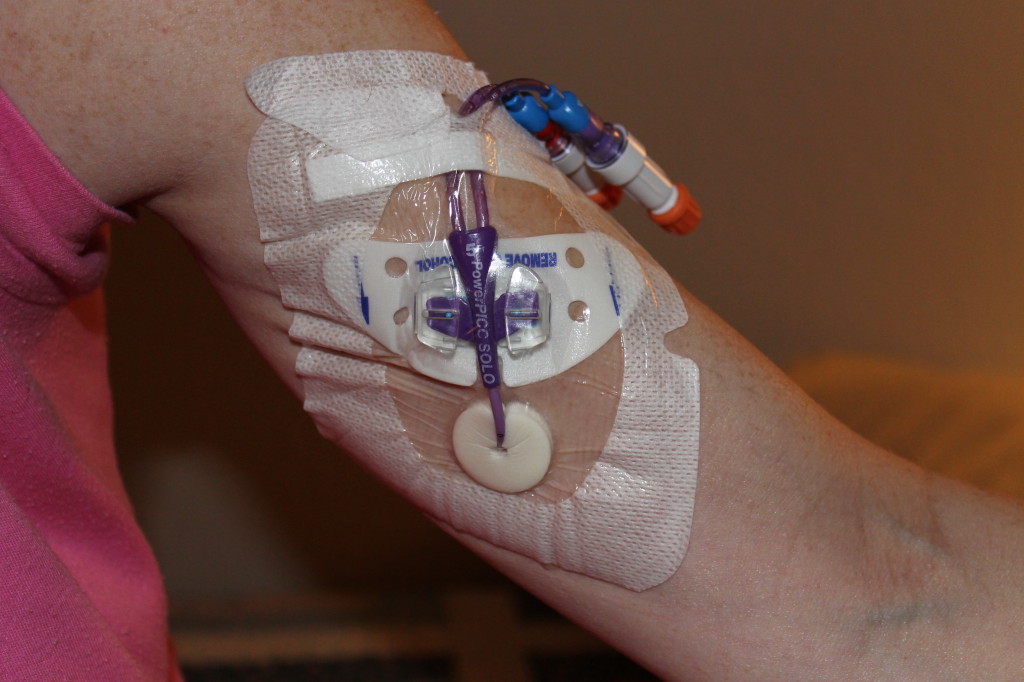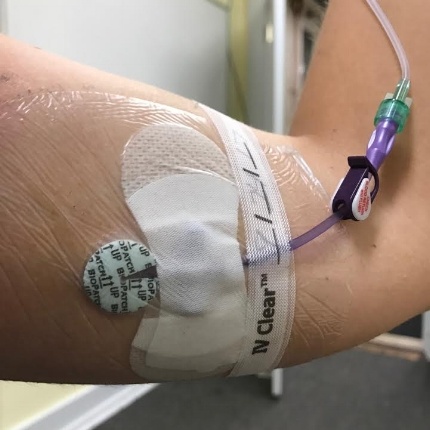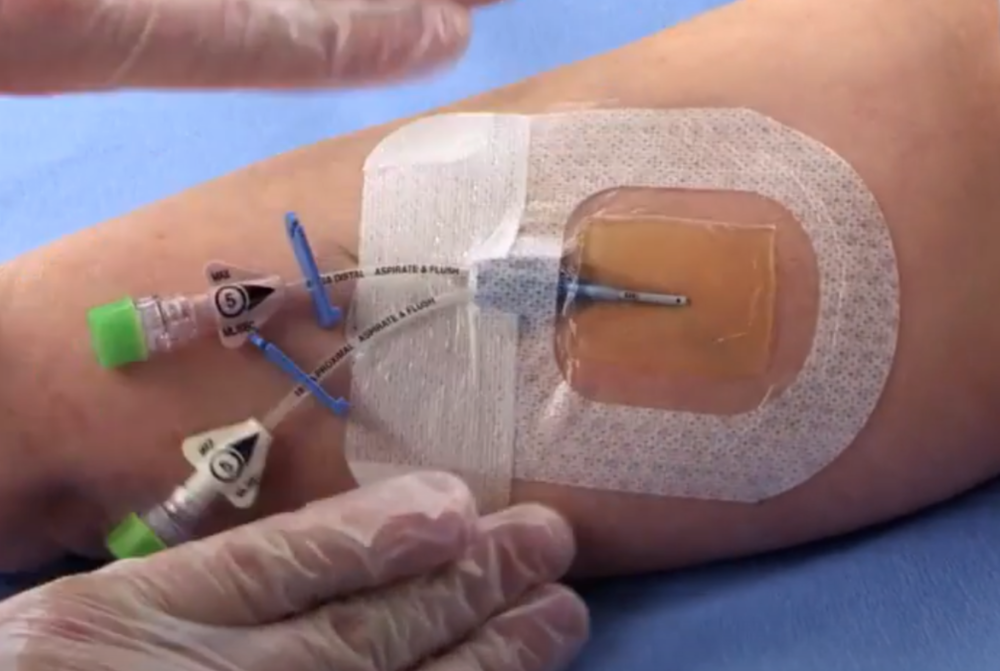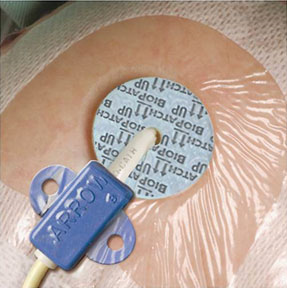central line dressing change how often
We wanted to see if there were any advantages or disadvantages to longer or shorter time intervals between CVAD dressing changes. At home you will need to change the dressing that protects the catheter site.
If at any time the dressing peels becomes wet underneath becomes dirty etc.

. According to the most recent CDC Guidelines 1 gauze dressings should be changed every 48 hours and transparent semi-permeable dressings every 7 days or earlier if the integrity of the dressings is compromised or there is blood. Participants were recruited from the intensive care and cancer care departments of one childrens and four adult hospitals. CVC Dressing Change Assess dressing status at least daily Replace dressing.
There has been a benefit demonstrated by 48 hourly dressing changes with the use of chlorhexidine washes at every change compared to similar care at 7-day intervals. Dry with a clean paper towel. For gauze and hypafix dressings I just document that it is clean dry and intact.
A daily inspection should ensure that the line is properly in place free from infection and in working order. Changing and flushing a central line access cap. Allow the area to dry on its own for at least 30 seconds.
Apply a BioPatch disk to the area around the PICC line making sure the foam side is on the skin and the grid side is up. Sterile technique must be maintained to prevent Central-Line Associated Blood Stream Infections CLABSI Nursing Points General. A peripherally inserted central catheter PICC is a long thin tube that goes into your body through a vein in your upper arm.
The dressing will not stick well to the chlorhexidine but will stick well to the SurePrep barrier film. Open your central line dressing change packet. Routine inspection of the central line regardless of location should be performed daily.
How often is central venous catheter healing done. Take your Sureprep Protective Wipe and draw a rectangle around the catheter site. It should be changed immediately.
Must perform these critical elements for successful completion. Changing the dressing frequently is also expensive. This includes gauze under a transparent dressing.
Cover the insertion site and patch with clear dressing. Some hospitals or healthcare facilities recommend changing dressings every few days while others keep dressings in place for longer. Dressing changes for central lines should occur every 5 to 7 days with a transparent dressing or every two days with a gauze dressing.
Intervention with a shorter interval between changes 2 to 5 days. Wash your hands for 30 seconds with soap and water. Step by Step Instructions on How to do a Central Line Dressing Change.
The end of this catheter goes into a large vein near your heart. Supplies for Clear Cap Change. Some kits may contain betadine or alcohol to sterilize the area.
Central Line Clear Cap Change and Flushing Instruction Sheet Change all clear caps every 7 days or any time the dressing is changed or if there is any blood in clear cap following flushing. How often these changes are done is a matter of contention. Clear caps for each line.
Dressing change packetyour mask is at the top or bottom Supplies. This includes PICC lines. Set up your supplies on a clean surface on a new paper towel.
The central line dressings should be changed a minimum of every seven days every 48hr if gauze is used. The studies used a variety of transparent dressings and compared a longer interval between dressing changes 5 to15 days. If you have a gauze dressing change it every 2 days.
Preventing infection while changing the dressing The central line provides a direct path into your bloodstream. Unfortunately that dressing does not allow you to see the catheter insertion site so the dressing must be changed every 48 hours. If 22 gauze used after initial insertion under occlusive Tegaderm dressing dressing must be changed in 24 hours.
In each study participants were followed up until the CVAD was removed or until discharge from ICU or hospital. Central Line Dressing Kit. Put on a pair of clean gloves.
Put on the mask. No need to fan or blow on the site. Wash your hands again.
If the dressing becomes loose dirty or wet change it right away. A nurse or technician will show you how to change the dressing. Line up the tubing and the slit.
The information below describes the steps for changing the dressing. Masks must be worn when changing clear caps. Intervention with a shorter interval between changes 2 to 5 days.
Remove all jewelry from your fingers. If this is not possible place a mask on the patient. Dressing change by wearing a mask or turning your head away.
If a patient has a sensitivity to Tegaderm dressings we will dress the central line site with gauze and hypafix. Central line dressings changes should be done every 7 days or as needed for peeling or soiling. Central venous catheters are used very frequently in intensive care units.
The mask is often at the bottom or top of the kit. Allow the site to dry. Follow any additional instructions your healthcare provider gives youTo change the dressing you need toIf you have been prescribed a dressing change kit follow the instructions for using supplies in that kitPrepare to change the dressing.
Every 2 days for gauze dressings Every 7 days for transparent dressings And whenever dressing becomes damp loosened or soiled Use aseptic technique and prepare clean skin with greater than 05 chlorhexidine with alcohol 13 OGrady NP Am J Infect Control 2011. Demonstrated by Cynthia McKenna Clinical Manager at American Home Health. However the evidence supporting these recommendations is limited.
However more frequent than 48 hourly changes are not associated with any improvement. Usually a pack of 3. The studies used a variety of transparent dressings and compared a longer interval between dressing changes 5 to15 days.
Be sure to wash between your fingers and under your nails. This is important to make sure the dressing seals properly. Report this to your healthcare provider as soon as possible.
Changing Your Dressings.

112 Central Venous Access Devices Eviq

Dressing A Central Line Properly Maimonides Emergency Medicine Residency

Nursing Skill Check Cvad Dressing Change Youtube

What Is A Picc Line Infusion Solutions Inc

Pin By Janet Shaw On Motor Skills Nursing Nurse Skills Nursing Videos Nursing Procedures

Central Line Dressing And Cap Changes Youtube

7 Things Not To Do With A Picc Line Mighty Well

Central Line Resources Dressing Change Youtube

Dressing A Central Line Properly Maimonides Emergency Medicine Residency

Picc Dressing Change Peripherally Inserted Central Catheter For Nurses Youtube

Central Line Dressing Change Kit With Chloraprepdefault Title Central Line Changing Kit Medical Supplies

Central Line Dressing Change Nursing Skills Youtube

Dressing A Central Line Properly Maimonides Emergency Medicine Residency

Central Line Dressing Change Nursing Skills Youtube

Picc Line Care Picc Line Dressing Change Clinical Nursing Skills

Dressing A Central Line Properly Maimonides Emergency Medicine Residency

Sterile Dressing Change To Picc Line Infermieristica

Peripherally Inserted Central Catheter Picc Care Instructions

5 Key Points Of Effective Biopatch Use Department Of Anesthesiology